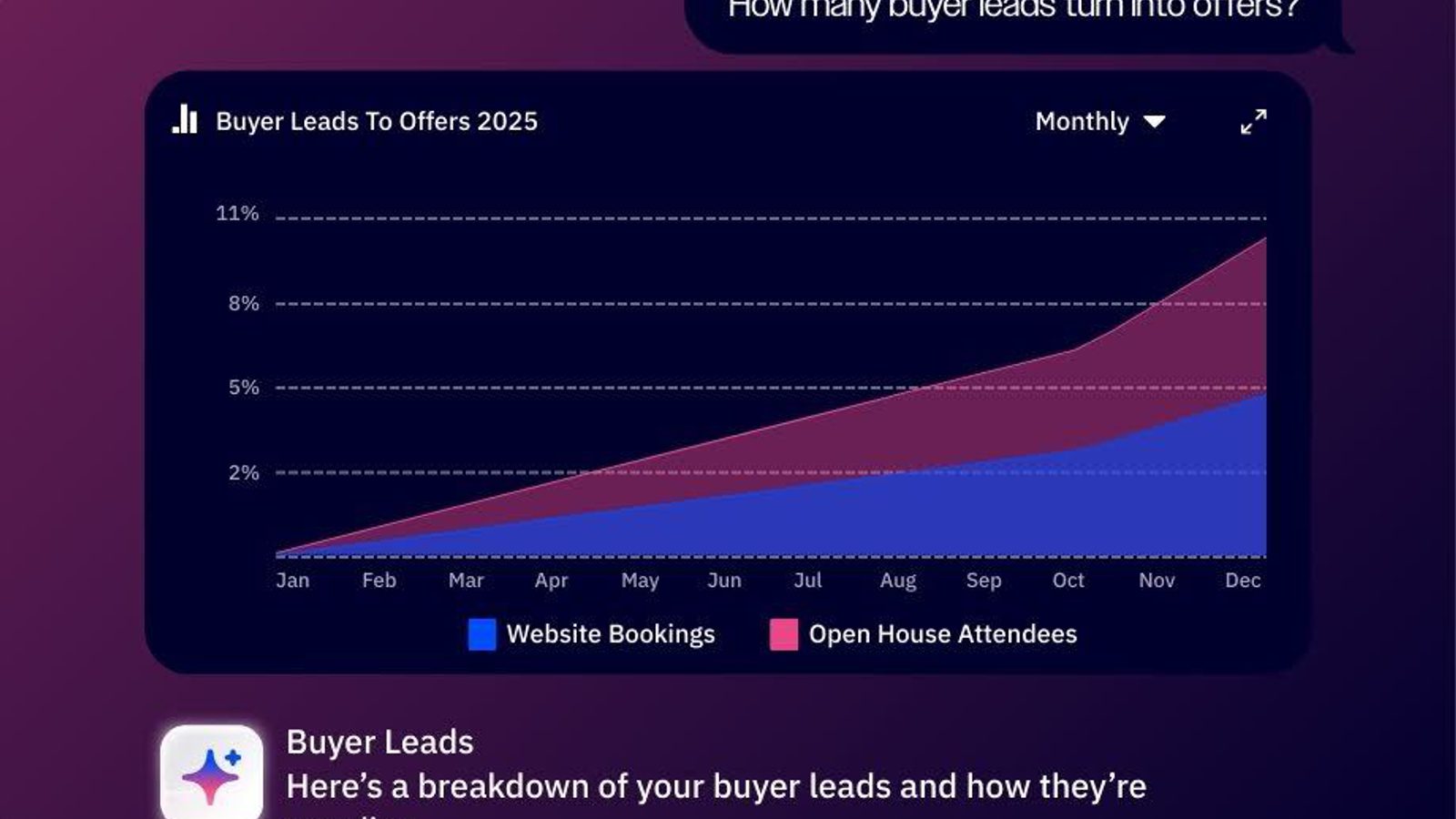Is your customer journey a straight line or a squiggle?
Does it seem straightforward when you think about how customers buy from you? For some, it might be as simple as seeing an ad, feeling the need, and saying, "Take my money." But for most, the path is much more tangled—they visit your website, leave, come back, contact your team, and maybe even disappear again before making a decision. Their journey is far from a straight line, and it’s a messy, winding road full of twists and turns.
That’s where a customer journey map comes in. This map outlines all the key touchpoints within the customer lifecycle, helping you visualize when and how customers interact with your brand. However, unlike the linear diagrams you might have seen in Marketing 101, real customer journeys are unpredictable, jumping from point A to point E, back to C, and beyond.
In this post, we’ll explore what a customer journey map is, why it’s messier than you might think, and how to create one that captures the real paths your customers take—with tips and customer journey map templates to help you get started.
What is a customer journey map?
A customer journey map is a visual tool that represents how a customer engages with your business throughout the entire customer lifecycle. It highlights every touchpoint a brand uses to nurture and retain its customers across the customer journey.
For example, your customer visits your website, signs up for your newsletter, and talks with a support agent on live chat. Then, 2 days later, the customer opens and reads your newsletter and revisits your website. All these interactions represent touchpoints in your customer journey.
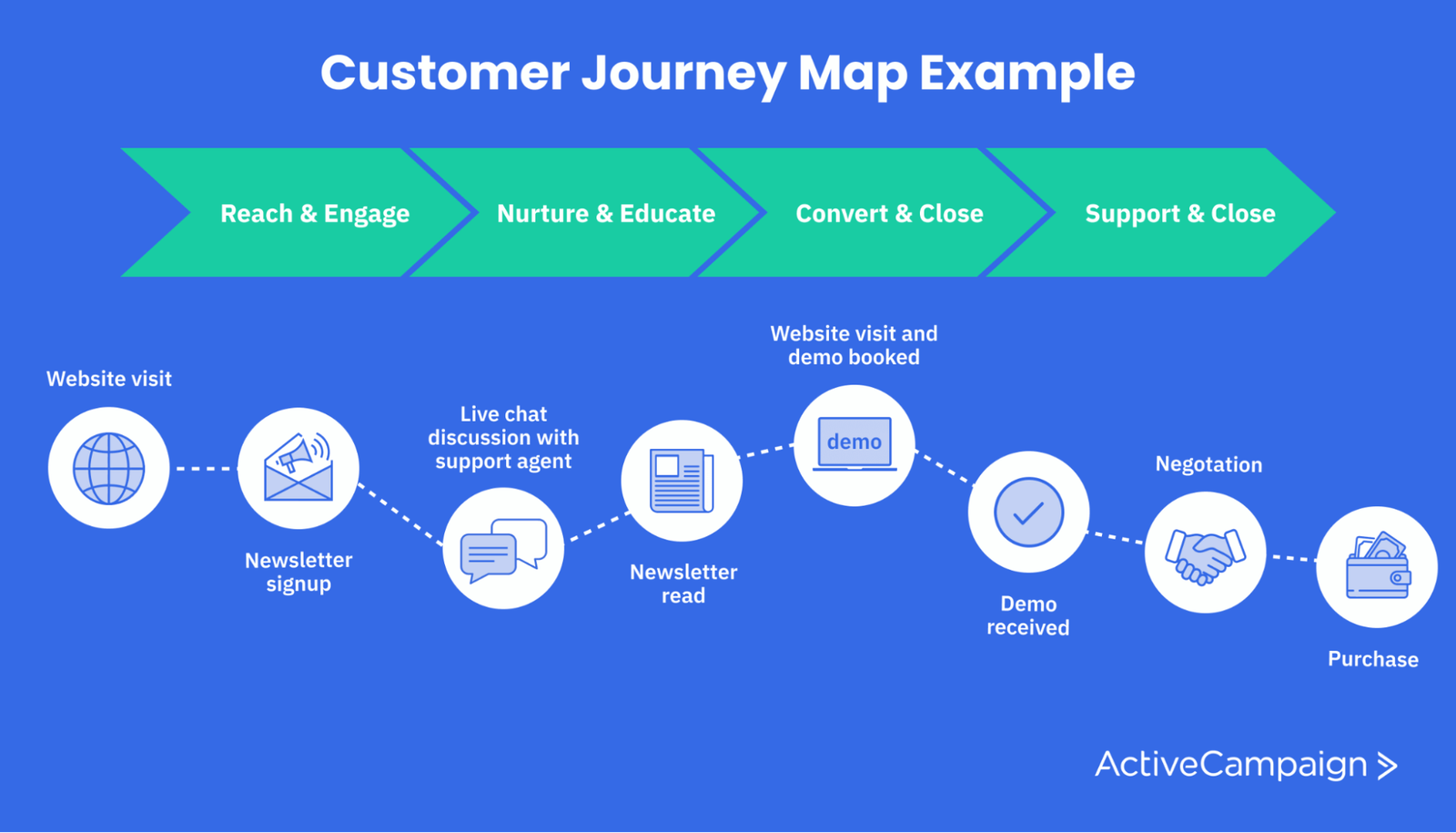
What if tracking down every single customer interaction feels overwhelming? The first time can feel like a lot, but after you've mapped the customer journey, you have more information to help grow your business. It's helpful in getting to know your customers and boosting brand awareness and sales.
Marketing consultant Stuart Hogg explains:
“It [Customer journey mapping] can give you and your team a greater understanding of how your customers are currently interacting and engaging with your brand and also help illustrate how your products and services fit into their lives, schedules, goals, and aspirations.”
Customer journey maps and experience maps give you a bird's eye view of your business from the customer's perspective. Understanding the entire journey is essential in this competitive market because each interaction varies for the average customer. You need to know precisely when, where, and how your brand engages with every customer.
The customer journey isn’t a straight line—it’s a squiggle
Is the customer journey really a straight line? Some marketers might like to think so: a potential customer learns about your business, does some research, considers their options, and finally decides to make a purchase. In this idealized view, the journey seems smooth, predictable, and easy to map out.
But in reality, customer journeys rarely follow such a tidy path. Instead, they’re a complex web of interactions across various channels and touchpoints. Customers might discover your brand through an ad, then search for reviews, visit your website, sign up for a newsletter, leave, come back after seeing another ad, and perhaps even engage with your team before they make a purchase decision. They move forward, backward, and sideways, jumping between online research, social media, word-of-mouth recommendations, and direct interactions with your brand.
Maggie Lin, a former product marketing manager at Solvvy, describes it well:
“Take a step back and think about how your customer could take one of any number of different paths to purchase. Rather than being something simple and linear, the buying decision is about the culmination of the entire customer experience and the various touchpoints your customer interacts with.”
Customers bring unique needs, behaviors, and timing in this messy journey, making it nearly impossible to predict an exact path. The process becomes more about managing a range of possible routes than drawing a single, defined line from start to finish.
The customer journey: perception vs. reality
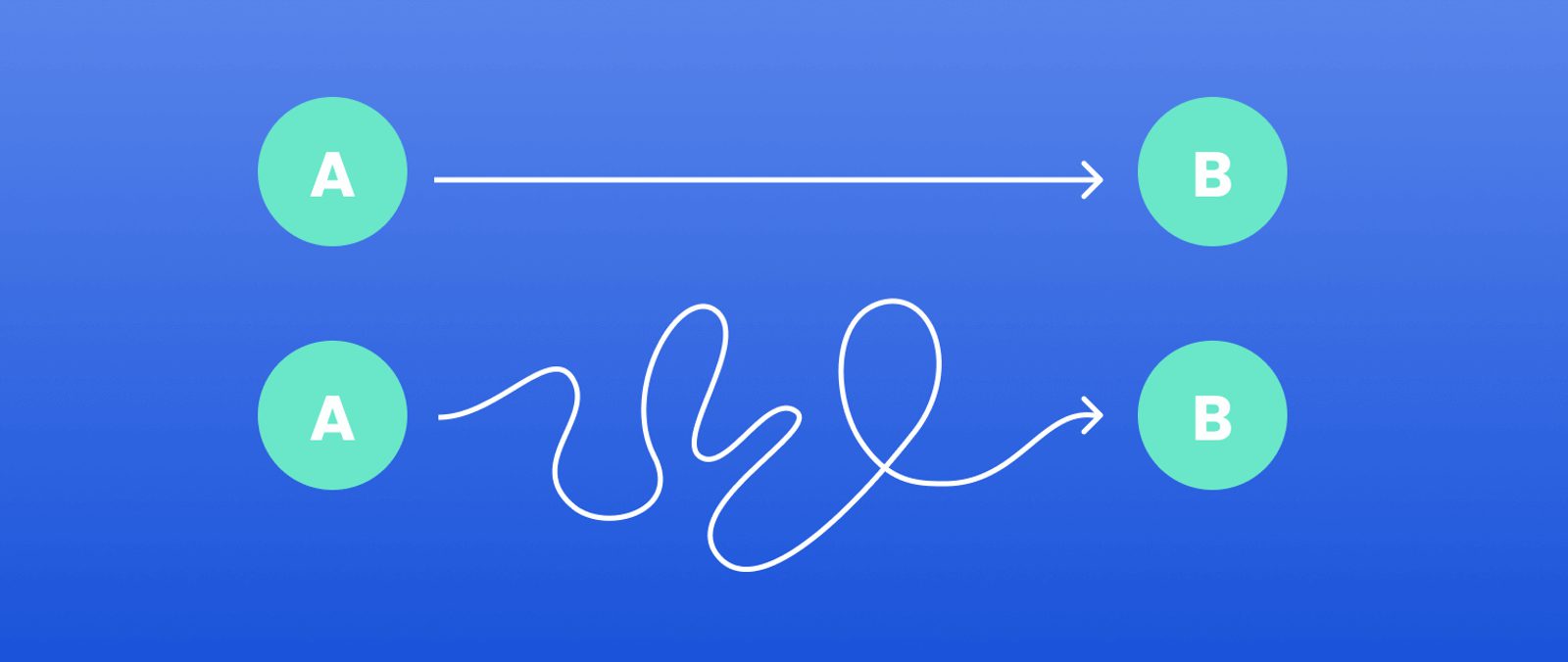
Customer satisfaction is a top priority for most businesses, regardless of industry or size. According to eduMe, 86% of customers will pay more for great customer service, with an average of 5.7x more revenue for companies that focus on the customer experience. Many companies are merging marketing, support, and sales into cross-functional teams to drive customer satisfaction at every stage.
Despite the focus on customer experience, there’s often a disconnect between what marketers imagine the customer journey to be and what it actually is. We might like to think that customers learn about our brand, receive the right information at the right time, and quickly make a purchase decision. But in reality, the journey is filled with detours, repeat visits, and multiple interactions across platforms.
Understanding and embracing the true, non-linear nature of the customer journey can make a significant difference in creating meaningful connections. By recognizing the "squiggle" that represents real engagement, businesses can create more responsive, adaptable strategies that align with how customers actually behave. This approach helps companies meet customers where they are and build loyalty by respecting the individuality of each journey.
What are the four stages of a customer journey?
Most customer journey maps are divided into four customer journey stages that span the entire customer lifecycle.
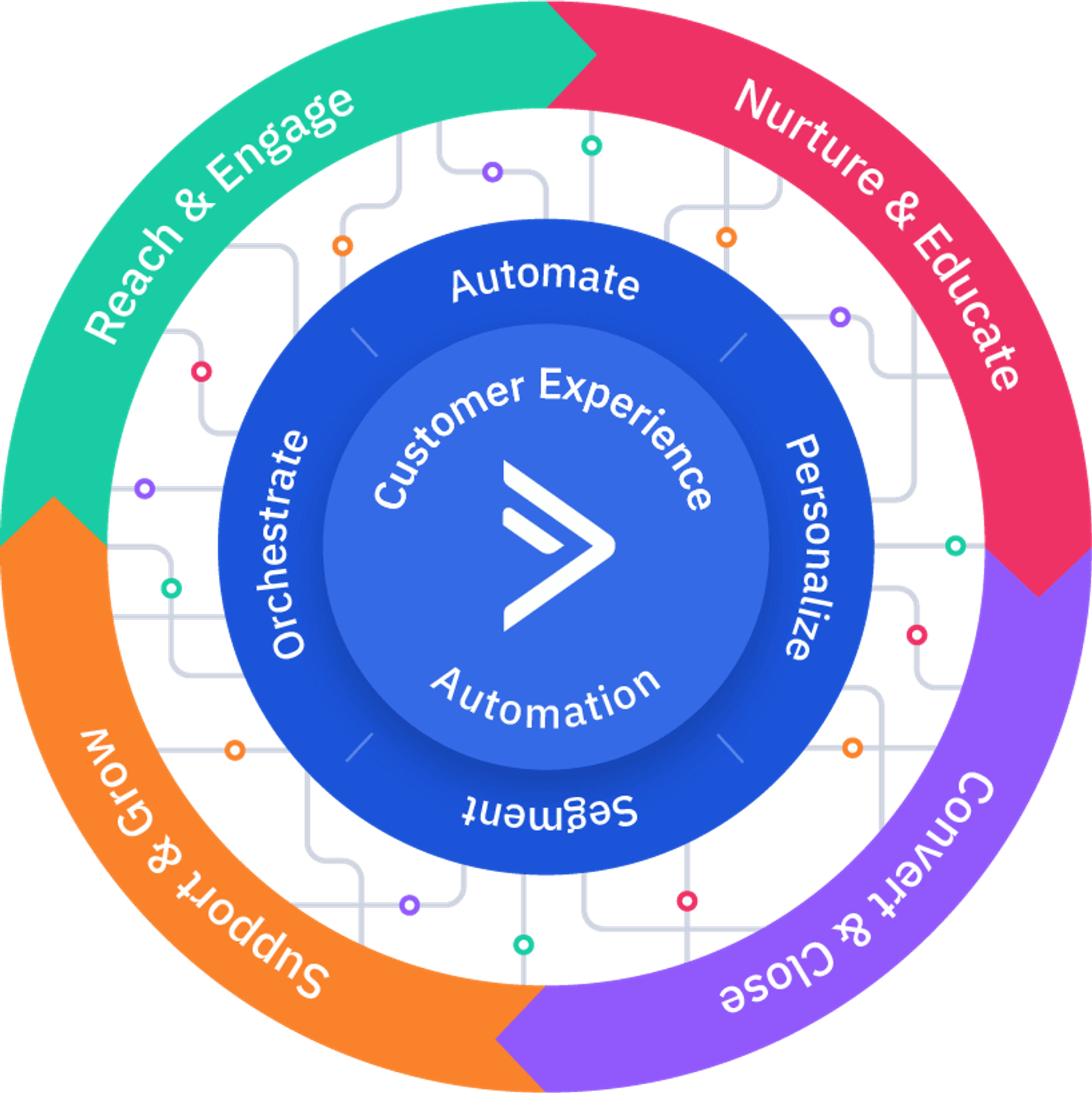
Spanning the entire lifecycle is key—to understand your customer journey, you need to understand how people start their buying decisions and what they do after making their first purchase.
The four stages of the customer journey are labeled differently across companies, industries, and sectors.
At ActiveCampaign, here's how we label and describe the customer journey stages:
1. Reach & Engage / Inquiry
The first stage of the customer journey is all about capturing attention and making that initial connection. This is where potential customers become aware of your brand through various channels like social media, search engines, or word-of-mouth recommendations. With the evolving landscape of digital marketing, reaching customers requires understanding how social media algorithms work and changes in advertising preferences. For instance, many users are now more inclined to engage with brands that appear in organic content rather than purely through paid ads.
- Targeted ads and algorithms: Platforms like Facebook and Instagram continuously refine their algorithms to prioritize content that resonates with users. As a result, brands need to create more engaging, authentic content to reach the right audience.
- Cross-channel or omnichannel marketing: Customers might first encounter your brand on Instagram, Google, or even YouTube. Effective cross-channel strategies ensure that your messaging is consistent and recognizable, no matter where customers see it.
This stage is about creating that initial spark of interest and collecting contact information, which could be as simple as getting a social media follow, a newsletter sign-up, or an inquiry form filled out on your website. Your goal is to intrigue and engage enough for customers to take that first step toward connecting with your brand.
2. Nurture & Educate / Comparison
Customers evaluate their options in this stage and compare different brands, products, or services. Providing value and building trust during this phase is crucial to stay top-of-mind. Customers today rely heavily on online reviews, comparison sites, and even influencer recommendations to make informed decisions. As they move from inquiry to serious consideration, your brand’s credibility and transparency are key factors influencing their choice.
- Online reviews & testimonials: Social proof is powerful. Potential customers often look for reviews on platforms like Google, Yelp, or Trustpilot. Make sure these reviews are visible and represent your brand accurately.
- Educational content: Providing valuable resources, such as blog posts, videos, or webinars, helps potential customers understand your offerings and feel confident in their choice. Educational content positions your brand as an authority, which can be a decisive factor in the comparison stage.
- Influencer Impact: For some industries, influencers and testimonials play a significant role. A recommendation from a trusted figure in your niche can significantly boost your credibility.
This is your opportunity to nurture the relationship by addressing specific needs, offering solutions, and showcasing how your brand stands out from the competition. By guiding potential customers through their comparison process, you make it easier for them to choose your brand when they’re ready.
3. Convert & Close / Purchase
The third stage is where the customer decides to make a purchase. Here, your goal is to provide a frictionless purchasing experience that reassures them they’re making the right choice. With the rise of e-commerce and mobile technology, buying has never been easier, and consumers have come to expect a seamless, efficient purchasing process.
- One-click purchases and mobile wallets: Many consumers appreciate the convenience of quick purchasing options like “buy now” buttons, Apple Pay, and Google Wallet. These options reduce the number of steps between decision and purchase, increasing the likelihood of conversion.
- Instant financing options: For higher-ticket items, offering financing or payment plans can make purchasing more accessible. Services like Klarna or Afterpay allow customers to spread out payments, reducing hesitation and increasing sales.
- Clear calls-to-action (CTAs): Well-timed CTAs in emails, on your website, or even within ads can help push a prospect to make that final decision. Effective CTAs are clear, action-oriented, and create a sense of urgency, encouraging customers to act immediately rather than postponing their decision.
An easy purchasing stage that is fast and straightforward means you’re improving the customer experience and increasing your conversion rate. The smoother the buying process, the more likely customers are to complete their purchase and return in the future.
4. Support & Grow / Onboarding & Upselling
After the purchase, your relationship with the customer doesn’t end—it evolves. The post-purchase phase is all about delivering value through excellent support, fostering loyalty, and turning customers into advocates for your brand. Personalized onboarding, ongoing support, and opportunities for upselling or cross-selling can significantly impact customer retention.
- Personalized onboarding: Guide new customers through your product or service to ensure they get the most out of their purchase. Onboarding emails, tutorials, and welcome messages are great ways to provide initial support and create a smooth transition from purchase to usage.
- Automated follow-up and support messages: Send follow-up emails or SMS messages to check in with customers, remind them of product benefits, or offer assistance. Automation tools make it easy to schedule these messages, ensuring consistent engagement without requiring constant manual effort.
- Opportunities for upselling and cross-selling: Once customers are familiar with your brand, they’re more likely to consider additional products or services. Offering personalized recommendations based on their purchase history can help increase lifetime value and build stronger brand loyalty.
Retention and loyalty are essential in today’s competitive market. You build a lasting relationship by staying connected, providing continuous value, and showing genuine appreciation for your customers. Happy customers are also more likely to become advocates, spreading positive word-of-mouth and helping you reach new potential customers.
What are the 5 A’s used for building a customer journey map?
Dr. Philip Kotler, a renowned marketing expert, developed a straightforward yet powerful framework for understanding the customer journey, known as “The 5 A's.” This model breaks down the journey into five key stages: Awareness, Appeal, Ask, Act, and Advocacy.
While customers may not move through each stage in a linear fashion, these steps provide a foundational approach to mapping out a customer’s path to purchase and beyond.
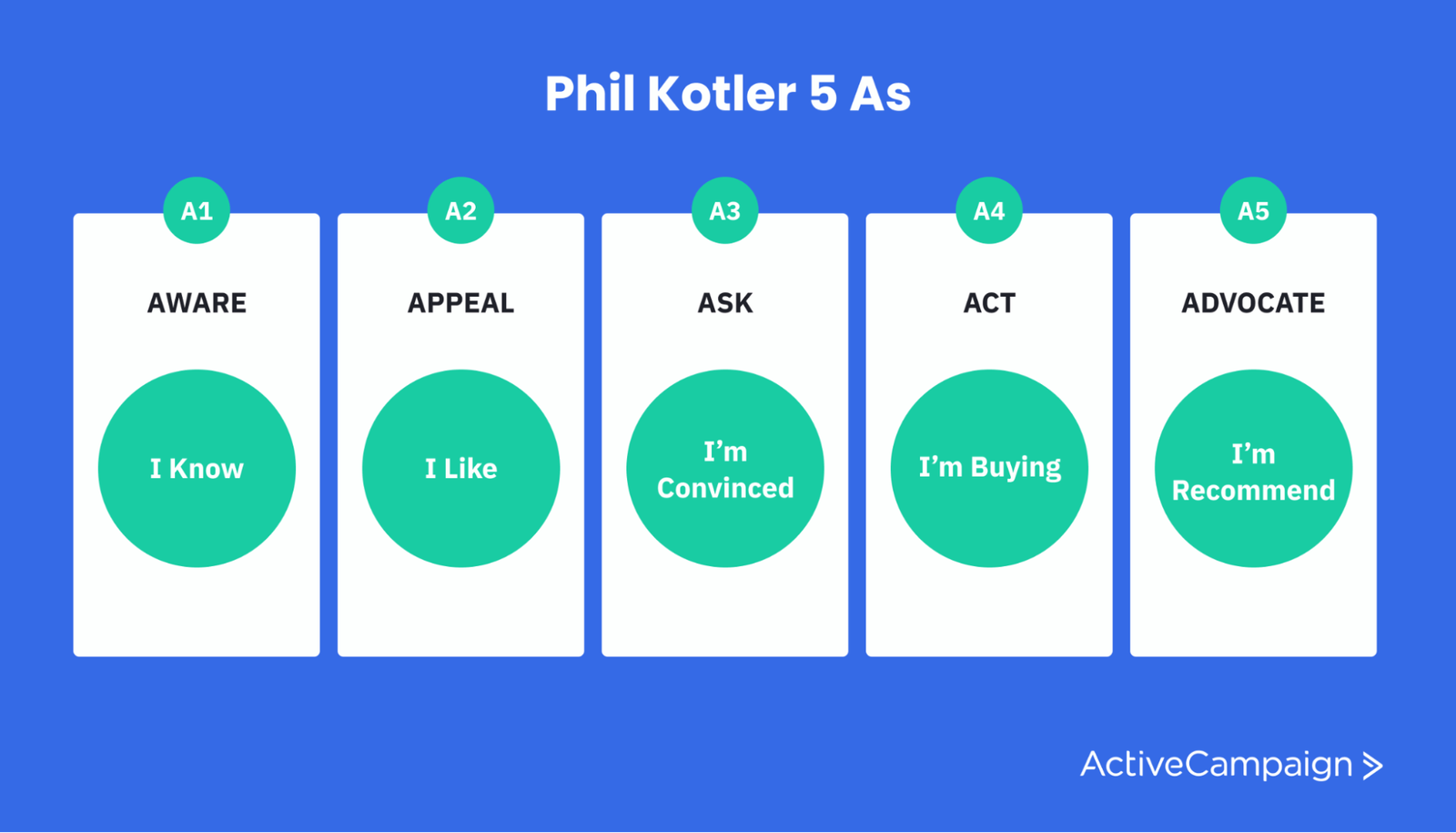
Awareness
In this first stage, potential customers gain initial awareness of your brand. This can happen through various channels, such as paid advertising (PPC, social media ads), organic content marketing (blog posts, SEO), or word-of-mouth recommendations. The goal in the awareness stage is to make a strong, positive first impression and place your brand on their radar.
- Where they might encounter you: Paid ads, social media, search engine results, or content shared by others.
- Your objective: Capture attention and spark curiosity, making it easy for people to recognize your brand in the future.
Appeal
Once customers know about your brand, the next step is to build interest and appeal. At this stage, they begin exploring what your business offers and see how it might address their needs or solve specific problems. For B2B companies, appeal often includes demonstrating how your solutions align with the customer’s business goals.
- Building appeal: Highlight benefits, showcase unique selling points, and address initial pain points.
- The customer’s mindset: “Could this product or service help me? Does it align with what I need?”
Ask
Customers seek more information about your product or service in the Ask stage. This is the research phase where they may engage with your company directly, ask questions, read reviews, or dive into product details. They want to confirm that your offering can meet their needs before committing.
- Common actions: Visiting your website, contacting support, reading case studies, or exploring testimonials.
- Your role: Be responsive, transparent, and informative. Answer questions promptly and provide detailed resources to help them make an informed decision.
Act
This is the critical moment when the customer decides to take action. They’ve done their research, considered their options, and are ready to make a purchase. The smoother and more straightforward this process is, the better. Offering easy checkout options, one-click purchasing, or even financing can make this stage seamless for customers.
- What helps them act: Clear calls-to-action, a user-friendly purchasing process, and multiple payment options.
- Your goal: Remove any friction in the purchasing process to ensure customers complete the transaction with confidence.
Advocacy
Customers who have a great experience often become advocates for your brand. Advocacy is the ultimate goal, where satisfied customers are so pleased with your product and service that they actively promote it to others. They might share their experiences through reviews, social media, or direct referrals. Advocacy doesn’t happen automatically—it requires consistently meeting and exceeding customer expectations.
- How to encourage advocacy: Customer experience programs, referral and loyalty incentives, and exceptional service are all great ways to help your customers help you by spreading the word.
- The customer’s perspective: “I’m happy to recommend this brand because they’ve consistently delivered value and positive experiences.”
Examples of customer touchpoints
Every interaction with your brand—online, in person, or through a third party—counts as a customer touchpoint. These touchpoints are critical moments where you can either build trust and value or risk losing interest. By strategically optimizing each touchpoint, you can lead customers smoothly through their journey, increasing the likelihood of a positive outcome. Customer touchpoints are typically divided into three main categories: pre-purchase, purchase, and post-purchase.
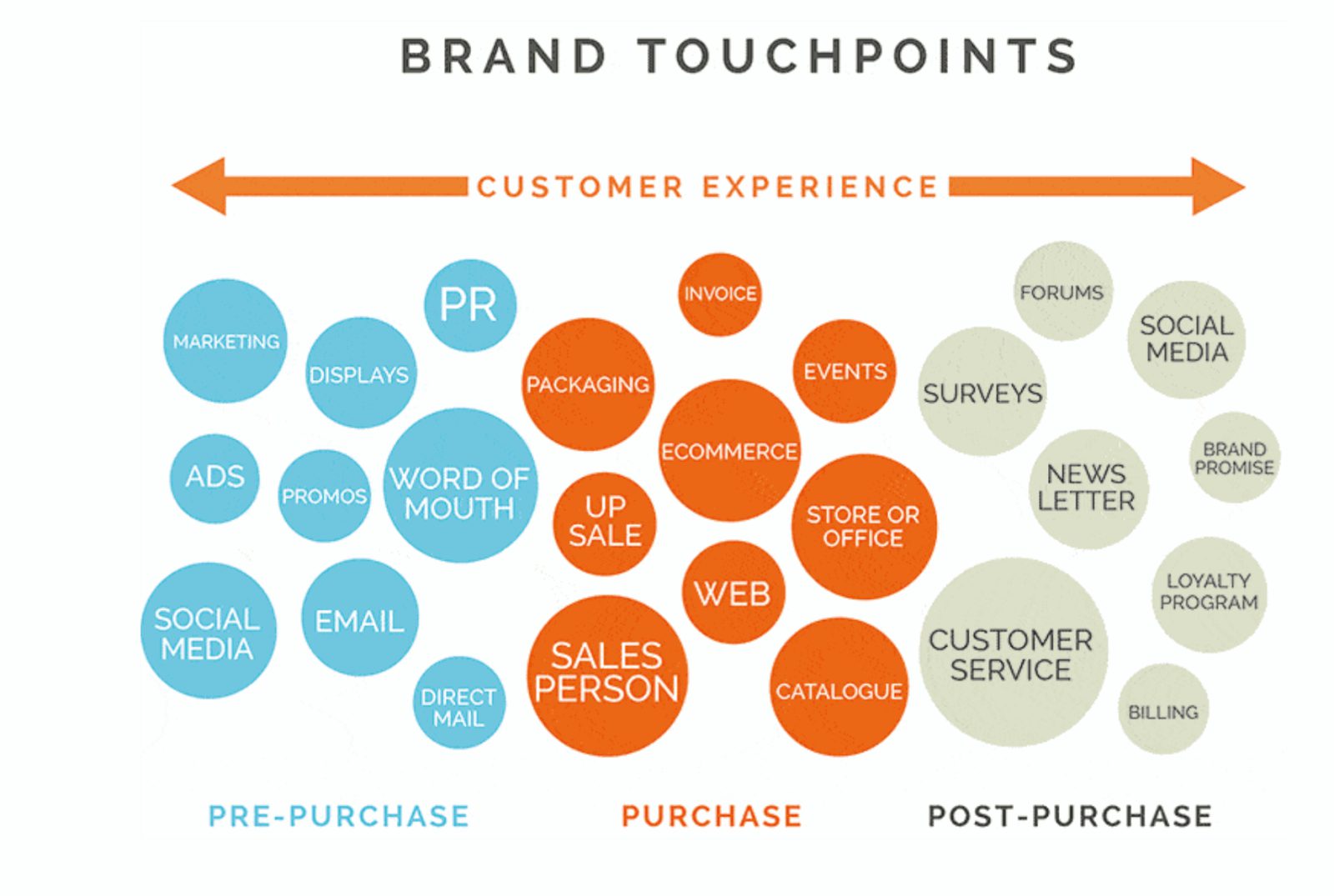
Touchpoints pre-purchase
Before customers commit to a purchase, they often interact with various brand touchpoints that introduce them to your products and services. This stage builds awareness, sparks curiosity, and makes a strong first impression. Pre-purchase touchpoints capture attention and guide potential customers into your sales funnel.
- Blog post: A well-written, SEO-optimized blog post that educates or entertains can help introduce customers to your brand and showcase your expertise.
- Facebook ad: Social media ads on platforms like Facebook allow you to target specific demographics, making it easier to reach your ideal audience with relevant content.
- Direct mail flyer: Physical mailers can effectively capture attention, particularly for local businesses or special promotions.
- Slack community: Participating in industry-related Slack communities can build brand credibility and provide a channel to engage with potential customers.
- Live chat conversation: Offering live chat on your website allows visitors to get real-time answers to their questions, providing a seamless way to address concerns and encourage conversions.
Touchpoints during a purchase
In the purchase stage, potential customers are actively considering or finalizing their buying decision. These touchpoints are crucial for delivering information, building confidence, and ensuring a smooth buying experience. By optimizing these interactions, you can create a seamless path to purchase and reduce any friction that could prevent customers from completing the sale.
- Webinar: Hosting a webinar lets you showcase your product in action and answer questions in real time, building trust and demonstrating value.
- Sales call: A personalized sales call allows you to address individual customer needs and tailor your pitch to their specific concerns.
- Case study: Sharing detailed case studies demonstrates how your product or service has benefited others, helping potential buyers see the real-world impact of their investment.
- Live demo: Product demos offer an interactive way to show your product’s features, helping customers understand how it works and how it might fit into their lives.
- Product reviews: Positive reviews from existing customers can be a deciding factor for those considering a purchase, providing social proof and reassurance.
Touchpoints post-purchase
The customer journey doesn’t end at the point of purchase—post-purchase touchpoints are essential for nurturing relationships, encouraging repeat business, and turning satisfied customers into advocates. These interactions play a key role in shaping the long-term perception of your brand and ensuring customers remain engaged even after their initial purchase.
- Loyalty program: Offering a rewards or loyalty program incentivizes customers to keep coming back, providing them with perks and making them feel valued.
- Feedback surveys: Post-purchase surveys give customers a chance to provide feedback, allowing you to gather insights and show that you care about their experience.
- Subscription renewals: For subscription-based businesses, the renewal process is a touchpoint that requires a seamless, transparent approach to retain customer loyalty.
- Onboarding campaign: A well-designed onboarding campaign helps customers get started with your product, increasing their comfort level and satisfaction with their purchase.
- Customer support conversations: Interactions with customer support—whether through email, chat, or phone—are opportunities to reinforce brand loyalty by providing helpful, timely assistance.
How to create your customer journey map
The customer journey mapping process can help you uncover valuable insights to drive business growth, but where do you start? Mapping the customer journey requires a deep understanding of your audience, including their preferences, needs, and how they interact with your brand. Although it may seem overwhelming to outline every touchpoint, don’t worry! The process becomes manageable when you break it down into key steps: defining your customer personas, gathering direct feedback, and identifying each customer touchpoint.
Start with your buyer persona research
A well-defined buyer persona is the foundation of an effective customer journey map. Buyer personas are semi-fictional representations of your ideal customers, encompassing key demographic and behavioral details that help you understand what drives their decisions. Here are some traits to consider when building a persona:
- Age
- Income level
- Gender
- Job title or role
- Motivations to buy
- Key influence drivers
To build an accurate user persona, start by gathering data on your existing customers. Conduct interviews, analyze customer data, and survey your audience to gain a clear picture of their preferences and motivations. Social media accounts, review sites, and even customer support logs can offer valuable clues about what matters most to your customers.
If you’re unsure where to begin, focus on one primary persona first. This approach lets you dive deep and understand a specific customer journey before expanding to additional personas. You can quickly implement insights and adjust your map based on real results by narrowing your focus. For help with questions to ask, refer to our guide on market research questions for customer surveys.
Get the best feedback there is: customer feedback
Customer feedback is one of the most valuable resources for building a customer journey map. It gives you a genuine view of how customers perceive your brand, what they enjoy, and where there’s room for improvement. This feedback can be gathered directly (through surveys or interviews) and indirectly (via third-party platforms or analytics), helping you identify key areas of customer pain.
Consider gathering feedback through these methods:
- Customer support and complaint logs: Review any recurring issues or common questions to identify pain points.
- Web analytics: Track customer behavior on your website to learn how they interact with specific pages or features.
- Customer interviews: Speak with both satisfied and unsatisfied customers to understand the full range of experiences.
- “How did you find out about us?” surveys: Prompt customers with this question after a live chat conversation or other initial interactions.
- Net Promoter Score (NPS) surveys: Send an NPS survey following customer support responses to gauge customer loyalty and satisfaction.
Gathering qualitative and quantitative data will give you a comprehensive understanding of your audience's experiences. This research can reveal important touchpoints that may not be immediately visible, providing a roadmap for improvements and opportunities for growth. Even small businesses can leverage these methods for effective market research, as outlined in our post on market research for small businesses.
List out every customer touchpoint
Once you clearly understand who your customers are and what they want, it’s time to list all possible touchpoints within their journey. Customer touchpoints are the direct interactions customers have with your brand—from visiting your website to receiving an email or attending an event. Each touchpoint should be mapped to a relevant customer stage to represent the entire journey accurately.
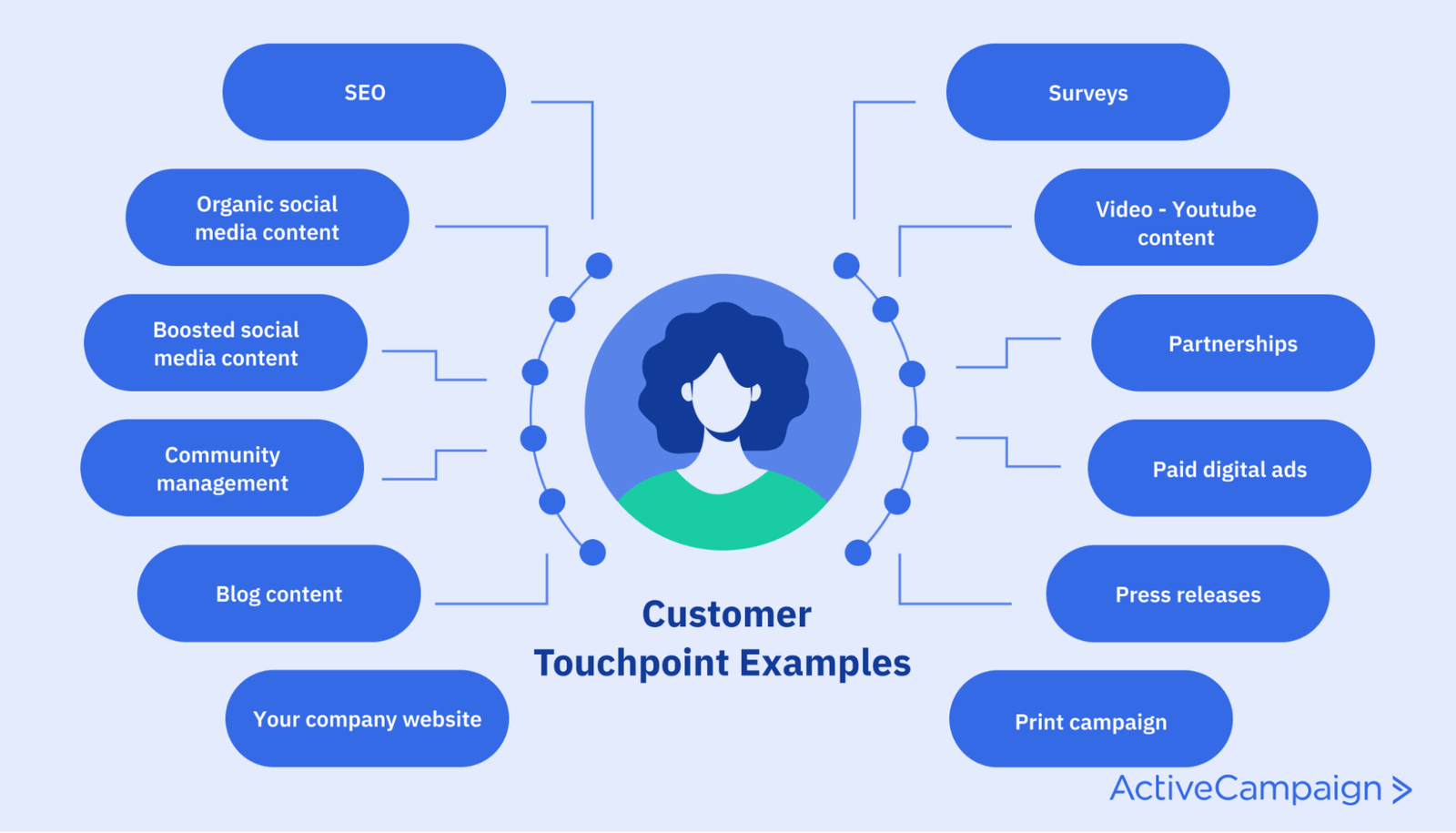
The nature and frequency of touchpoints may vary depending on your business’s sales cycle:
- Instant purchases: Some customers may quickly decide and complete their purchase immediately after finding your website.
- 30-day process: Others may take more time to conduct additional research, consider alternatives, or persuade team members before buying.
- Extended cycles (six months or more): For large businesses, particularly in B2B sectors, the sales cycle may involve multiple touchpoints over an extended period, often with several stakeholders involved.
Identifying each touchpoint is essential for understanding the customer experience from start to finish. By recognizing when, where, and how customers interact with your brand, you’ll be better equipped to improve each stage of their journey, streamline processes, and maximize opportunities for engagement.
What are the benefits of customer journey mapping?
If you don't know how people buy from you, how can you expect to sell to them?
When you map out a customer journey, you can find two types of opportunities:
- You find moments of influence that you didn't realize existed. Do you know how to influence those conversations when future customers get a recommendation in a Facebook group, from a review site, or just from a friend?
- You find moments of impact that affect almost every customer. If every customer submits a contact form, you had better make sure your form is easy to submit. If every customer needs to use your checkout page, that's a great place to focus your attention.
The biggest benefit of customer journey mapping is that it helps you find those high-value moments. Your to-do list will always be longer than your “I will actually do this” list, so focusing on the parts of your business that impact the most sales is important.
Customer journey mapping can also show you where you're already spending the most time. If you discover a step that involves sending a lot of manual follow-ups (for example, following up with someone who submits a contact form), you've identified a prime candidate for automation.
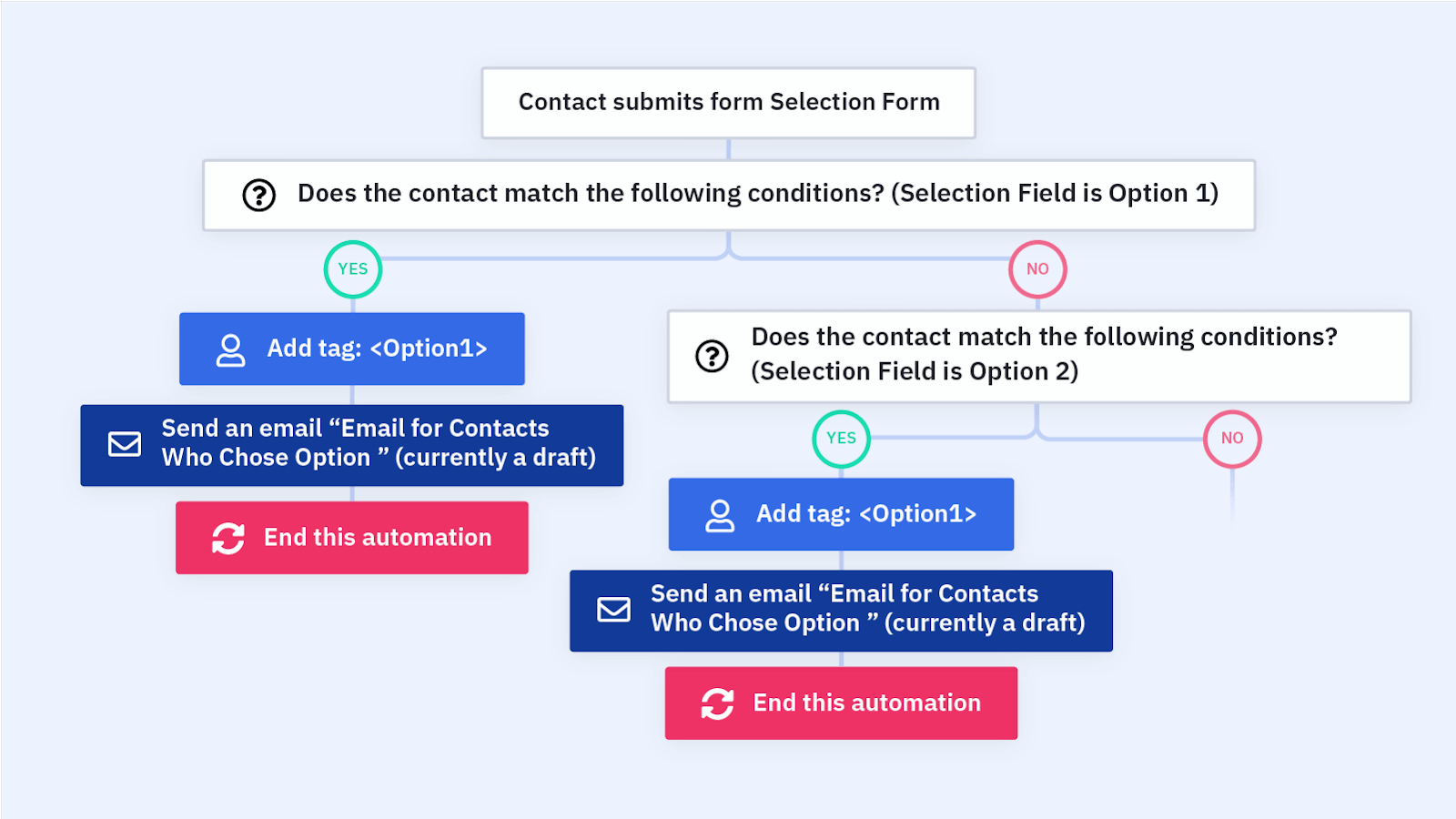
As an example of automation—mapping out her customer journey helped ActiveCampaign customer Heather save 10 hours every week by automating her follow-up.
As a photographer, Heather had many people submit her contact form. But even though she had to follow up with every single person, very few of them were actually a good fit for her business. They were “zombie leads”—people who eat time but never become customers.
Setting up lead scoring and automated follow-ups let her clear out zombie leads and spend more effort on her top customers.

Not long ago, customer journey mapping was considered an essential task for marketing teams. Marketing and product teams would work together to map out the customer journey on a whiteboard, but that's when fewer touchpoints existed.
Nowadays, customer journey mapping centers around identifying what your customers do in the buying process so your entire team can focus and automate its marketing efforts to drive more sales. Your brand benefits from knowing how marketing, sales, and customer support interact with every customer. That way, your business knows whether you're communicating too much or too little with your target audience.
Here are more benefits of customer journey mapping:
- Streamline the user experience: Your team can pinpoint opportunities to enhance each customer interaction. Set up automated workflows to send tailored messages when customers take a specific action, like visiting a particular landing page or signing up for a demo.
- Predict consumer behavior: Get a deeper understanding of the customer's actions to strengthen engagement. You can use predictive sending to forecast optimal times to email each customer.
- Identify operational inefficiencies: Reducing costs is just as important as earning more revenue. Customer journey mapping helps you replace repetitive processes with automation. Use sales automation to update deals and create tasks in your CRM automatically.
A customer journey map that helps you grow
Adapting to a complex, non-linear customer journey is essential for driving growth in today’s competitive landscape. By using customer journey and customer experience maps as a visual representation of each stage, your team gains insights to better understand customer behaviors, address their needs, and create memorable experiences that lead to loyalty.
ActiveCampaign is a powerful tool to help you design and manage every aspect of your customer journey. From automated emails that engage customers at key touchpoints to CRM features that keep track of customer interactions, ActiveCampaign streamlines the process of building connections and nurturing relationships. With ActiveCampaign, you can create a seamless, personalized journey that evolves with your customers’ needs—empowering your business to adapt, grow, and succeed.Take control of your customer journey today, starting with a 14-day free trial of ActiveCampaign, and ensure every interaction moves your business closer to its goals.


